The activity of shooting pool evolved from a form of French croquet. Played on a lawn, a ball (or bille, hence the title billiards) would be shoved around the field by wooden maces. The game was then moved inside - French royalty hated to sweat - but to keep the connection to the lawn, the game was played on a table covered with green cloth to represent grass. How regal.
All that history is fine and dandy, but we prefer the current image of pool: a dimly lit barroom filled with wispy strands of smoke, while you, with a pool cue in one hand and a brew in the other, stand there and look dangerous. It's a well-documented fact that if you hold a cue stick in your hand, your coolness level increases exponentially. We're here to make sure that you can do more than merely look cool while waiting for your turn. So read on and learn the basics about shooting pool.
And, if you need all the cool points you can get, don't mull over the steps. Get on the ball and view this video.
WATCH THIS HOW-TO VIDEO
1. FAMILIARIZE YOURSELF WITH THE EQUIPMENT
Um, isn't there like some balls and a table and other stuff? A brilliant analysis! To be more specific, here are the main pieces of equipment with which you should familiarize yourself:
Balls
Cue stick
Table
Rack
Balls
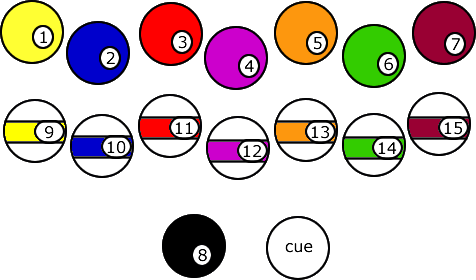
Ooh, look at all the pretty colors! The first thing to know about pool is that there are many balls. Some of these balls are solids, meaning that the entire ball is one color, and some of these balls are stripes, meaning that the balls have white tops and bottoms, with a colored stripe painted around the middle.
Each ball also has a number on it, 1 - 15. All of the balls 1 - 7 are solids, and all the balls 9 - 15 are stripes. What about the 8-ball? Well, when playing standard pool, the 8-ball is not considered a solid nor a stripe; it's special. Don't worry, you won't miss the 8-ball -- it's all black.
There is one more ball that you'll use when playing pool, but it doesn't have a number on it. It's the cue ball, and it's the ball that you'll hit with the cue stick. When playing pool, you never hit any of the balls directly with the stick; you only hit the cue ball with the stick, and then the cue ball bounces into other balls and knocks them into the holes on the table.
Cue stick
The cue stick is the stick you use to hit the cue ball. It's long and pointy, so be careful; many an eye has been poked out by a rambunctious player who decided to play conductor and use the cue stick as a baton. A cue stick has three parts:
- The tip: the little white piece -about half an inch long-at the end of the skinnier half of the stick.
- The shaft: the smooth, narrow length between the tip and the middle of the stick.
- The butt: the thicker portion of the stick that falls between the middle and the end, with a rubber bumper on the very bottom
Stop snickering. We didn't invent the names. Pool sticks are free for the borrowing at pool halls. Don't try filching one because the owners will spot it sticking out of your back pocket. Don't worry about the length of a cue stick (most of them are about 58 inches long), but if you feel that your cue is too heavy, switch to a lighter one; what you lose in power, you'll gain in control.
Table
We realize that the "artistic" rendering below is woefully out of scale. But until our art budget increases, perhaps you'll be satisfied with this image of a standard pool table:
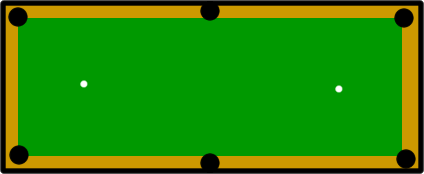
A pool table is about 4 feet wide, 9 feet long, and usually has a velvet-ish surface (acutally, it's polyester and wool). On the table, there are 6 pockets: there are 4 corner pockets (shockingly located at the four corners of the table) and 2 side pockets, one in the center of each long side of the table.
A pool table also has rails. These are the borders around the edges of a pool table where people rest their beers. There are two important things to know about the rails: 1) you'll be using them to balance your non-dominant hand to make rail bridges; and 2), you should NEVER put any drink or food item on the rail. If it spills onto the table, the surface material will need to be replaced, and then you'll cry because it costs a lot of money to do this (at least $150).
One last thing about the table: near each end, there's a little white circle called a spot. You need those, because when you set up the balls at the beginning of a pool game, the front ball will rest on the foot spot, while you'll set the cue ball on the head spot.
Rack
The rack is the triangular thing that players use to arrange the balls into a neat triangle shape before the game starts. See it in the picture on the top of the page? The process of using a rack is called racking, and there is an art to it:
- Pack all the balls into the rack.
- With your fingers inside the back end of the rack, push the balls forward and close together within it. All adjacent balls should be touching.
- Rack with the front ball centered on the foot spot.
- When you lift the rack, the balls should remain snugly packed together.
The last two common pieces of pool equipment are the mechanical bridge and the chalk. Don't worry too much about these; we'll discuss them later. Just know that you use the bridge to help you make tough-to-reach shots, and you use the chalk to help your cue stick connect with the ball.
2. LEARN THE LINGO
re are tons of pool terms out there, and we're not going to bore you with all of them; we'll just give you the basics so you can follow a standard game with your drunk friends. Believe us: memorizing this list of pool vocabulary will be worth the effort. Print it out and wear it around your neck. (Just don't carry it into the pool hall unless you actually want to get beat up, dork.)
Billiards vs. Pool
"Billiards" and "pool" are not the same thing. "Billiards" refers to all cue sports, including pool, carom (a game that involves a pool table with no pockets), and snooker (a British version of pool); however, pool is a specific type of billiards game. Use this useless tidbit of knowledge to intimidate your opponents.
- Cue ball: The white ball. It's the only ball that the cue is allowed to touch. Ever.
- Object ball: The first ball that the cue ball hits.
- Break: The break occurs at the very beginning of a game. When a game starts, somebody has to hit the cue ball first, sending into the neatly racked colored balls. This first hit is called the "break." You can also use it as a verb (as in, "Whose turn is it to break?").
- Pocketing a ball: Getting a ball into a pocket; pocketing a ball is also known as "sinking" a ball.
- Scratch: While you want to get your own balls into the pockets (we'll get to the rules of the game later), you NEVER want to get the cue ball or your opponent's balls into a pocket. Whether you do it on purpose or by accident, whenever you hit the cue ball or an opponent's ball into a pocket, you have "scratched" and will be penalized. By the way, you also scratch if you hit the cue ball, but it completely misses hitting any balls.
- Frozen: When an object ball is directly touching another ball or the wall of the table. These balls can be tough to hit properly. In the example below, the 6-ball is frozen.

- Position play: This is the act of hitting the cue ball with the necessary speed (and spin, if needed) to get the cue ball to end up someplace on the table where you'll be able to get the next ball in easily. In short, it's the strategy of thinking ahead and setting up your next shot.
- Hustler: A hustler is someone who goes into a pool bar pretending to suck, finds some losers that really do suck, and then tries to trick the losers into betting huge amounts of money on a pool game. A hustler will miss easy shots on purpose during a low-stakes game, and then when the losers offer to bet big money on another game, the hustler will "miraculously" kick ass and take the losers' money.
Some fancy moves
There are all kinds of fancy moves you can do when hitting the cue ball into an object ball. Here are some examples:
- Cut: When you hit a cue ball squarely into an object ball, the object ball will move in a straight line. However, if you cut, that means that you hit the cue ball so that it hits the object ball on the side, allowing the object ball to travel at an angle. In the example below, the cue ball hits the 4-ball at an angle, so that it cuts to the left.
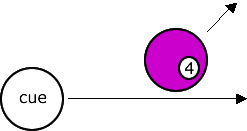
- Banking a shot: This is when you hit the cue ball, the cue ball hits an object ball, and the object ball bounces off a wall of the table. If you can bank a shot into a pocket, it means that you are good or lucky. Below is an example of a bank shot: the cue ball hits, the 2-ball, which bounces off the wall and continues (hopefully into a pocket).
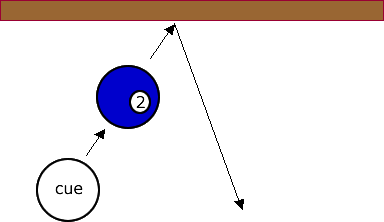
- Combination: This is when you hit the cue ball into an object ball, which in turn hits a second object ball (on purpose). Below, the cue ball hits the 15-ball, which in turn hits the 1-ball.

- Draw: You don't have to hit the cue ball square in the middle; if you like, you can hit the cue ball towards the bottom, creating spin. That way, when it hits the object ball, the cue ball will roll back towards you. This is called draw.
- Topspin: an effect that makes the cue ball spin forward at a greater rate of spin than if it were rolling naturally.
- English: This is when you hit the cue ball on the right or left side so that it spins.
3. PRACTICE MAKING A SHOT
The hardest part of learning pool is to hit the cue ball properly. Once you can hit the cue ball where you want to, you can then send it to hit other balls and subsequently sink those balls into the pockets. Here's how to prepare to hit a basic shot:
Setting up
Making the shot
Breaking
Setting up
- Grab a cue stick.
- With the stick in hand, stand close to the table with legs lined up perpendicularly to the edge of the table.
- Keep your feet parted about a shoulder's length and balance your weight equally between both feet.
- Bend the knee closer to the table slightly while keeping your back knee straight, and lean towards the table.
- Grip the butt of the cue stick with your dominant hand.
- Put your other hand palm down on the rail or surface of the pool table (depending on where the cue ball is) about 5 - 10 inches away from the cue ball.
- Lift your thumb slightly, and lay the shaft of the cue in the crease between your thumb and the side of your hand. Try sliding the stick back and forth in the crease. It should slide smoothly and evenly. (Because your hand is acting as support for the shaft, this is called a bridge.)
- If your hand can't reach to 5 - 10 inches from the cue ball, consider using a mechanical bridge, which is a cue stick with ridges on the end. You merely put the end of the mechanical bridge 5 - 10 inches away from the cue ball, and it will give your cue stick the support it needs to make a steady shot.
Making the shot
So you're in the perfect position to make a shot don't screw things up by feebly poking at the cue ball with your stick. Here's how to actually hit the ball:
- Slide the stick back and forth in your bridge a couple of times to get your arm moving and your balance together.
- When you feel ready, pull back and strike the cue ball at its center. At the precise moment that the stick comes in contact with the ball, your dominant arm should be at a 90-degree angle.
- Follow through on all your shots. Following through means extending your dominant arm in a straight line following the direction your cue ball went. You should follow through at least a couple of inches on all shots, and a whole foot or more on powerful or breaking shots.
- Before you strike the cue ball, you MUST aim. The trick to getting the object ball where you want it to go is to determine the point where it'd be propelled in the proper direction:
- When you're first learning how to play, walk over to the object ball that has the greatest potential to drop into a pocket, and mentally draw a line from the pocket to the center of the ball.
- Pretend that the line extends through the ball. The point where the line ends at the back of the ball is the exact point that you want the cue ball to hit it.
- Aim the cue ball at this mental point on the object ball. If the cue ball has no way of directly reaching the point, there's no shot to be made there. Find another object ball.
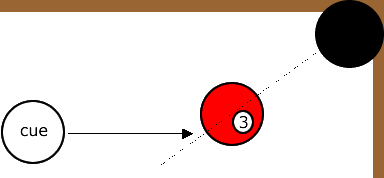
Note the picture above. If you draw an imaginary line from the pocket straight through the 3-ball, you'll see exactly where you have to hit the 3-ball to sink it. So aim the cue ball at that exact spot on the 3-ball, and it should go in.
- As you improve, you'll make this imaginary line out of habit; you'll be able to judge where you should hit the object ball simply by glancing its position on the table. But until you get to that point, ignore everyone else's groans and take your time drawing these mental lines. It's the only way to learn to aim.
It can be particularly difficult for a beginning pool player to break a racked set of balls. Here's a good way to practice:
- Put the cue ball on the headspot. (When you get good, you can position the cue ball anywhere next to or behind the headspot to make the break.)
- Hit the leading ball of the rack squarely in the front.
- Follow through an extra 6 - 18 inches.
- Always hit the cue ball as hard as you can, or else the balls won't break apart fully. How embarrassing would it be to hit the cue ball into the racked balls, and not break any of them apart?
4. LEARN TO PLAY 8-BALL (STANDARD POOL)
When people talk about playing pool, they're almost always talking about about 8-ball. The basic point is simple: you will either be the solid balls or the striped balls (your opponent will be the opposite). The goal is to get all of your own balls in and then sink the 8-ball before your opponent can do so. BUT, you can't sink the 8-ball until all of your own balls have been pocketed.
Keep in mind that there are tons of variations on the rules of 8-ball, but this version is basically correct and is best for beginners:
Racking
You use all 15 balls for 8-ball. Put the 8-ball in the middle and the 1-ball in front. For the rest, just alternate striped and solid balls throughout the remainder of the triangle (this won't work out perfectly, but do the best you can).
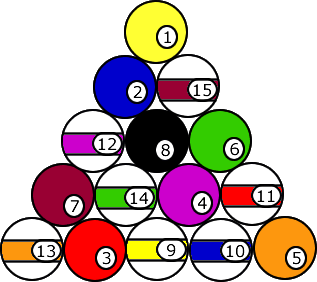
The rules
- Flip a coin to determine who's going to break.
- Let's say that you win the coin flip and get to break. Then go for it. Starting now, you and your opponent (let's call her "Monica") switch turns (each getting one turn) until someone sinks a ball.
- Whoever sinks a ball first becomes that type of ball (a solid or a stripe). So if you sink a ball first and it's a 14 (stripe), then you are stripes and Monica is the solids.
- If you pocket a ball on the break, then it still counts; you are the type of ball that you sank. HOWEVER, if you're not happy with the ball you pocketed on the break, you can "refuse" it and attempt to pocket the other type of ball. This can only occur on the break.
- If you happen to sink TWO balls on the break (or if Monica has yet to sink a ball and you're still trying to determine who is what), and one ball is a stripe and the other is a solid, then you get to pick which type you want to be.
- If you pocket a ball on the break, then it still counts; you are the type of ball that you sank. HOWEVER, if you're not happy with the ball you pocketed on the break, you can "refuse" it and attempt to pocket the other type of ball. This can only occur on the break.
- Whenever you (or Monica) sinks a ball, you get rewarded by getting another turn. This is always the case, whether you sink a ball on the break or later on.
- As we said earlier, the object is now for you to sink all your balls first while avoiding the 8-ball. Once you have pocketed ALL of your type of ball, you can then try to sink the 8-ball. If you sink the 8-ball at ANY point before your balls are cleared, you automatically lose the entire game.
- For the 8-ball (and only the 8-ball), once you get your chance to sink it, you must declare beforehand which pocket you are aiming for. If it goes into another pocket, you lose. If it goes in your pocket, you win! If you miss but it doesn't go into another pocket, Monica gets a turn and you don't get another turn until she misses a shot.
Scratching
Remember "scratching"? It means that you either hit the cue ball into a pocket, your opponent's ball into a pocket, or you didn't hit any balls at all. When you scratch, you automatically lose your turn. Here are some more specific details about each case:
- "I hit the cue ball into a pocket!" If you pocket an object ball and the cue ball on the same turn, the object ball is removed and placed back on the table (on the footspot), and the cue ball is placed anywhere on, next to, or behind the headspot, as decided by Monica.
- "I hit Monica's ball into a pocket!" If you pocket Monica's ball, your turn is over and her ball stays in the pocket. It's just bad luck for you that you happened to help her.
- "I didn't hit any balls!" If you hit the cue ball and it doesn't come into contact with any other ball, then you lose your turn unless it bounces off 3 walls of the table before coming to a stop. If you do scratch, then Monica can pick up the cue ball and move it on, next to, or behind the head spot.
- "I scratched, and all I have left is the 8-ball!" If you scratch in any way described above, and you only have the 8-ball left to sink, then you lose. We're terribly sorry. Because this can be incredibly frustrating, novices may want to eliminate this rule until they get better.
5. LEARN SOME OTHER POPULAR GAMES
8-ball isn't the only pool game out there; some of the other most popular games include 9-ball and cutthroat. Here are the basics of how to play each one:
9-ball
This is the game that the professionals on TV play. But you can try too.
- In 9-ball, the only balls you'll use (besides the cue ball) are 1 - 9.When you rack them, line them up with one ball in the first row, two in the second, three in the third, two in the fourth, and one in the last, so that the balls form a diamond shape.
- The 1-ball should be at the head (front) of the rack, and the 9-ball in the center. All the other balls can go anywhere you want.
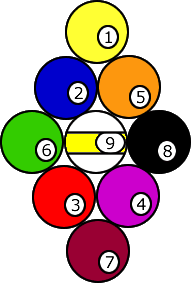
- The object of 9-ball is to sink the 9-ball. Here's the catch: all the other balls must be eliminated first in numerical order, starting with the 1-ball, then the 2-ball, 3-ball, etc.
- The only way to get another turn is to sink the correct ball in the pocket.
- If you sink the wrong ball, then you lose your turn, but you don't take that ball out of the pocket.
- All the rules of scratching apply. There's one exception to this: the 8-ball now counts as any other normal ball.
- If a scratch does occur, the next player can place the cue ball anywhere he/she wants on table (this is called "ball-in-hand"). So whatever you do, DON'T SCRATCH!
- Some people play tougher variations of this game. For instance, one version requires the shooter to not only sink the lowest number ball on the table, but he/she must also hit that ball first with the cue ball (virtually eliminating the option of using combination shots).
Cutthroat or Elimination
This is a great game if you're playing pool with people you hate, or if you happen to be an annoying person by nature.
- Before the game starts, the balls are divided evenly and assigned amongst the players. So in a three-person game, Player A will get balls numbered one through five, Player B - six through ten, and Player C - eleven through fifteen.
- If the balls can't be divided up evenly, give the more experienced player(s) fewer balls.
- Rack the balls as you would for a game of 8-ball.
- The object of the game is to eliminate all the balls on the table that are not yours. So if you're Player A, you want to sink balls six through fifteen.
- Once all of a player's balls have been pocketed, he/she is out of the game. The other players continue playing until the bitter end.
Because pool, like most sports, is easier to grasp when you see it being done, you should consider watching an instructional tape. With practice, perseverance, and a well-rehearsed pool face, you will soon be well on your way to becoming a pool shark. We're scared of you already!

